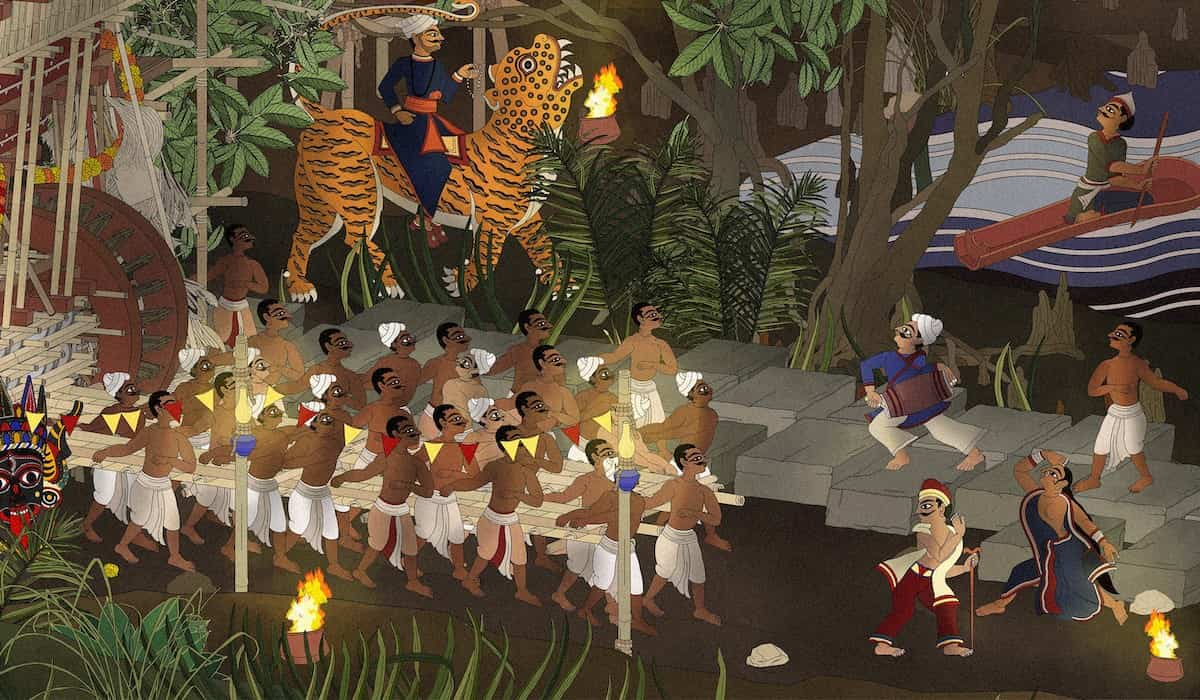Negotiating Narratives: Rituals, Myths and Resistance in Arinjoy Sen's Works
By Terrain.art | Oct 29 2021 · 5 min read
Sen’s digital works reimagine power and conflict in India through a reinterpretation of Mughal miniatures and Kalighat patachitras.
If narrative art tells a story, then Arinjoy Sen is a master storyteller. Since stories take place in certain spaces and times, the challenge for an artist is to bring them together on the two-dimensional plane of a canvas in a way that lends a sense of immediacy for the viewers towards the subject matter of the story being depicted.
Kolkata-born, London-based Sen reconfigures space and time through his heavily embellished, Mughal miniature- and Kalighat patachitra-inspired archival prints to tell stories of shared histories, myths, and collective resistance of communities living at the margins of the postcolonial society.
But don’t let these seemingly decorative works fool you. Through his stunning digital works, some of which are currently on display in Terrain.art’s ongoing exhibition, Rituals of Time, Sen tells the story of the fragile landscape of Sundarbans — a marshy forest area, stretching over 10,000 square kilometres between the countries of India and Bangladesh - and its forest dwellers.
Contested Geographies
Arinjoy Sen’s luminous digital artworks bring to life the fragile and contested landscape of Sundarbans, peopled by marginalized communities, whose rituals of daily life stand in stark contrast to the persecution at the hands of the state machinery and the vagaries of nature.
The forest of Sundarbans, formed by the confluence of Ganga and Padma rivers, is intersected by a complex network of marshy islands, waterways, and mudflats. The islands are home to a variety of endangered flora and fauna, including the Royal Bengal Tiger. Conservation efforts have prompted the government to declare large parts of territory as protected, state-owned land, although rampant environmental degradation due to natural and man-made disasters continues.
The protected status of this fragile biosphere is to the detriment of the people of Sundarbans, as it prioritizes the non-human over human life. The tragic Marichjhapi massacre of 1979 at the behest of the Left Front government, which led to the mass eviction and killings of Bengali Hindu Dalit refugees inhabiting the protected islands of Sundarbans, is one such event that exemplifies the plight of these marginalized communities living at the borders of postcolonial India.
Rituals of Resistance
Arinjoy Sen’s project is divided into two parts – the first part chronicles details of the daily lives of the fishing community, while the second part deals with rituals of traditional forms of storytelling, such as jatra (travelling folk theatre).
Through stylized depictions, inspired by the brightly coloured and detailed miniature paintings of the Mughal court, Sen depicts a self-sustained village community living at the frontiers of modern society. It is difficult for the viewer to ascribe a temporality to the subjects of these works, as the characters seem to be caught in some unchanging mythic time of the past.
In several of his works, such as Ritual and Walls and Rituals of the River, common village folks appear side by side with folk gods and goddesses, animals, and symbols of local religious practices — women of the fishing communities bring freshly caught fish to the market, villagers pray in front of Bon Bibi’s shrine (a popular folk goddess of the region whose propitiating verses are sung to evoke blessings), and the myth of Gazi Pir (a 12th-century Muslim saint who said to have controlled ferocious animals and natural elements) comes to life. These works depict the marginalized fishing communities of the region as protectors of the forest land rather than as encroachers, living a self-sustained life despite natural calamities and the spectre of the state violence haunting them.
Practices of Storytelling
The second part of the project deals with the practices of storytelling. According to Arinjoy Sen, “Storytelling is a means of surviving the erasure of identity and history. It becomes a site of resistance against discursive omissions, especially against the minority and the marginalized.” Sen anchors his act of storytelling in the tradition of jatra — a type of travelling folk theatre popular in eastern India. Unlike western proscenium theatre, a jatra is performed on an open-air stage with audiences sitting on all sides. Accompanied with lively music and dance, and often peppered with bawdy dialogues, jatra performances recount tales of gods and goddesses, local heroes and popular folk tales that have been passed from one generation to another through oral narrative practices. But they might also recount tales of resilience and resistance of the local people against external hostilities.
In Negotiating Narrative, Memory and Erasure, we see police forces burning down houses of villagers, while another group offers prayers to Gazi Pir – the Muslim patron saint of the region.
In another work, Procession, Memory, Identity II, the idea of a public ritual is embodied in the form of a Rath (traditional chariot) being drawn by villagers. Although this idea of a totemic car originates in the temple cars of Odisha, in Sen’s works, the juggernaut serves as a theatre space for jatra artistes. In doing so, Sen leverages Bakhtin’s notion of the “carnivalesque” – a trope used to subvert dominant hierarchies of power, albeit temporarily, through humour and chaos. In Sen’s narrative art, however, the carnivalesque manifests in the apparatus of the jatra or travelling theatre becomes a medium for a contradictory cultural construction that, through its enactment, continuously reconstructs notions of cultural identity, historical consciousness, and the political power of the narrative form.
You can now view Sen’s works in Terrain.art’s ongoing digital exhibition, which will run till December 17, 2021.

